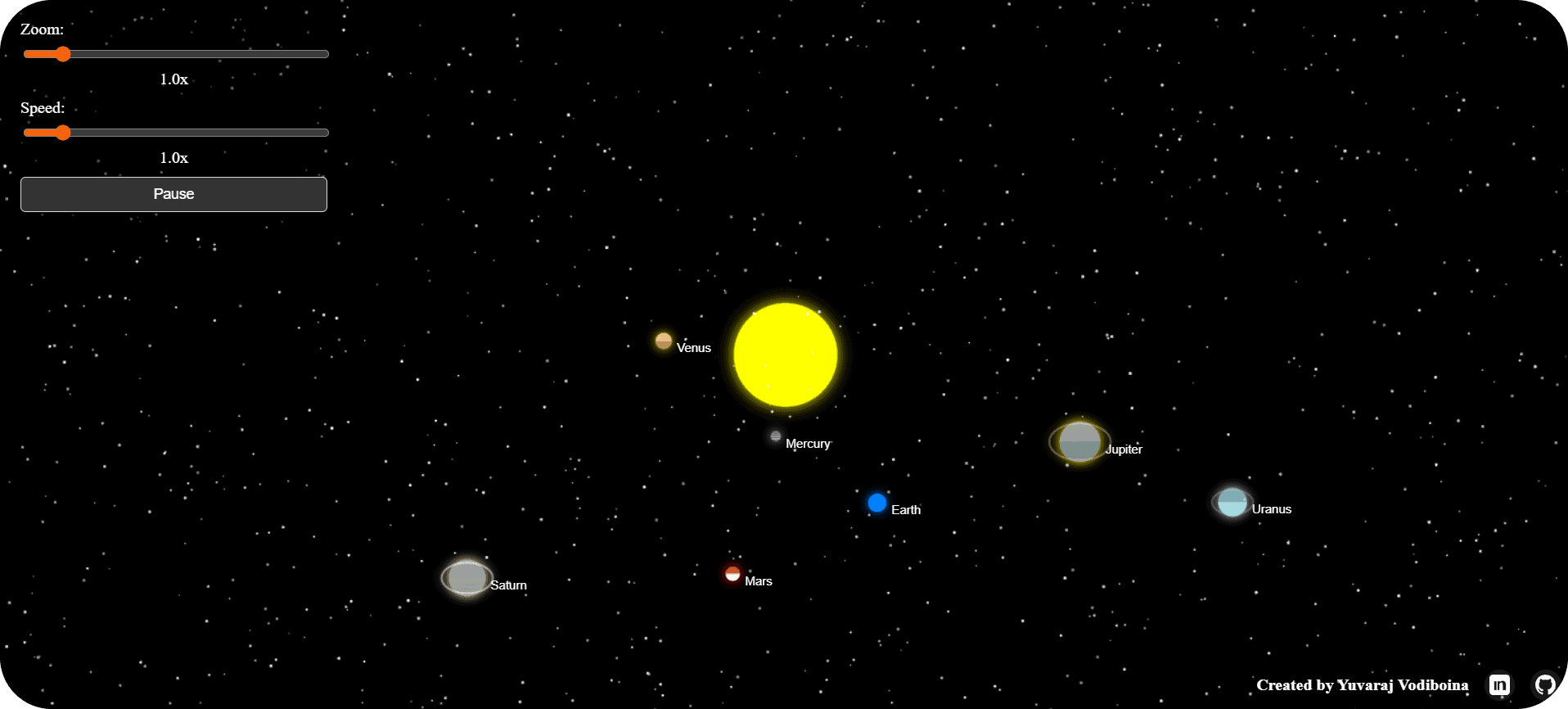
This interactive solar system simulation brings the cosmos to your browser with stunning visuals and realistic physics. Built entirely with web technologies, it features all 8 planets orbiting the sun with accurate relative speeds, high-quality textures, and interactive controls that let users explore our solar system in an engaging, educational way.
Key Features
Realistic Simulation
- All 8 planets with accurate relative orbital speeds
- High-quality 2K planet textures from NASA sources
- Realistic distance ratios and planet sizes
- Pulsating sun effect with dynamic glow
- 1000-star animated background for depth
Interactive Controls
- Zoom control (0.5x - 5.0x) with smooth transitions
- Speed control (0.5x - 5.0x) for time manipulation
- Pause/play functionality with visual feedback
- Dynamic planet labels that follow orbital motion
- Real-time control panel with instant updates
Technical Excellence
- Smooth 60fps animation using requestAnimationFrame
- Dual-canvas architecture for optimized performance
- Texture caching system for efficient loading
- Smart zooming that maintains visual coherence
- Cross-browser compatible with fallback systems
User Experience
- Fully responsive design for all device sizes
- Touch-friendly controls optimized for mobile
- Intuitive interface with clear visual feedback
- Educational planet information and facts
- Professional UI design with modern aesthetics
Technical Architecture
Planet System & Data
Planet Configuration
- Mercury: Fastest orbital speed (0.04), closest to sun
- Venus & Earth: Similar sizes with distinct textures
- Mars: Characteristic red appearance
- Jupiter & Saturn: Largest planets with unique patterns
- Uranus & Neptune: Outer planets with slower orbits
Visual System
- High-Quality Textures: 2K textures from solarsystemscope.com
- Glow Effects: Canvas shadow properties for planet atmospheres
- Dynamic Labels: Planet names that follow orbital motion
- Starfield Background: 1000 randomly positioned animated stars
Performance & Deployment
Optimization
Texture caching, efficient rendering loops, and minimal DOM manipulation for smooth 60fps performance
Deployment
Cloudflare Pages hosting with global CDN, automatic HTTPS, and fast worldwide access
Accessibility
Mobile-responsive controls, keyboard navigation support, and cross-device compatibility
Educational Value & Future Potential
Learning Experience
- Interactive exploration of our solar system
- Visual understanding of planetary motion and scale
- Educational tool for astronomy and physics concepts
- Engaging way to learn about space and celestial mechanics
- Realistic representation of planetary characteristics
Future Enhancements
- 3D rendering upgrade using Three.js framework
- Additional celestial bodies: moons and asteroid belts
- Sound effects and ambient space audio
- Detailed planet information panels and facts
- Orbital trail visualization and multiple star systems
Conclusion
The Solar System simulation balances visual fidelity with performance, creating an educational, responsive experience that runs smoothly on the web.
From a technical perspective, the project demonstrates careful attention to performance and accessibility: optimized animation loops, texture caching, and a responsive layout ensure a consistent experience across devices. Controls are keyboard-friendly and touch-optimized so users can explore comfortably on mobile and desktop.
Looking ahead, the foundation is ready for incremental upgrades: migrating to a 3D rendering pipeline with Three.js, adding moons and asteroid belts, and layering in richer educational content. These enhancements will deepen immersion while preserving the app’s approachable, classroom-ready design.